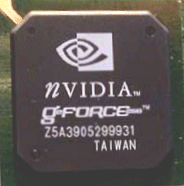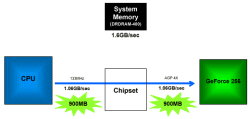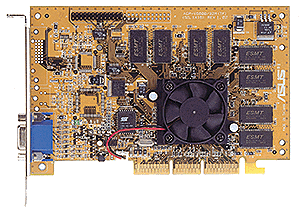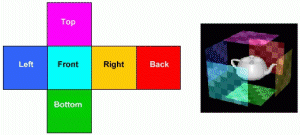GeForce 256

The time has come and ... and the NVIDIA server running Lotus Domino just stopped processing http requests. As a result, many who wanted to know what the change in the world consists of and what caused this change simply could not get to the NVIDIA website. True, literally immediately the informational hunger was quenched, since on most sites related to computers and news, all the necessary information was provided to everyone. It was announced loudly, but, in fact, the GeForce 256 was an evolutionary step, but by no means a revolution.

Even the fact that a day earlier NVIDIA S3 Corporation announced its new product Savage2000, which in terms of its parameters was at least as good as GeForce 256, did not spoil the general enthusiasm. At the same time, NVIDIA preferred to pretend that there were no announcements from S3 at all, and in relation to GeForce 256 the epithet "the world's first graphics processor for the mass market with an integrated geometric accelerator" was used everywhere. The first such product, at least officially announced, was the Savage2000 from S3. A blunder in the parameters of the GeForce 256, such as the supported vertical frequency of 75 MHz (!) at resolutions up to 2048x1536, was generally ignored by the press. The holiday turned out to be a success. What was the price of an auction on eBuy, where a GeForce 256-based card with developers' paintings was sold for 00,
The first GPU for the people The GeForce 256 chip from nVidia was one of the first consumer-grade chips to carry a geometric coprocessor. The presence of this coprocessor allows you to process the transformation of wireframe objects at the hardware level and calculate lighting in real time. This generation of 3D accelerators had to be characterized by the following characteristics:
AGP 4x and Fast Writes
S3TC Texture Compression HDTV
Environment Cube Maps Up to 64MB SDRAM, SGRAM, DDR SGRAM Hardware texture and lighting support. High fillrates
NVIDIA GeForce 256 Specifications
| Name | GeForce 256 |
| Core | NV10 |
| Process technology (µm) | 0.22 |
| Transistors (million) | 23 |
| Core frequency | 120 |
| Memory frequency (DDR) | 166 |
| Bus and memory type | SDR/DDR-128bit |
| Bandwidth (Gb/s) | 2.6 |
| Pixel pipelines | 4 |
| TMU per conveyor | 1 |
| textures per clock | 4 |
| textures per pass | 2 |
| Vertex conveyors | No |
| Pixel Shaders | 0.5 (emulation) |
| Vertex Shaders | 1.0 (emulation) |
| Fill Rate (Mpix/s) | 480 |
| Fill Rate (Mtex/s) | 480 |
| DirectX | 7.0 |
| Anti-Aliasing (Max) | SS-4x |
| Anisotropic Filtering (Max) | 2x |
| Memory | 32MB |
| Interface | AGP4x |
| RAMDAC | 350MHz |
ArchitectureThe GeForce 256 had 23 million transistors and was manufactured using a 0.22 micron process. NVIDIA simply did not have time to complete the work on the transition to a 0.18 micron process, and it was due to the use of a 0.22 micron process and a large number of transistors that NVIDIA was forced to limit the clock frequency of the GeForce 256 core to 120 MHz, as otherwise, you might have problems with overheating of the chip and even with power supply. In the GeForce 256, the geometric part involved in T&L and Clipping operations had impressive computing power at that time. The GeForce 256 could produce up to 15 million z-buffered textured polygons per second. Integrated GPU. In general, GPU stands for Graphics Processor Unit. Simply put, the GPU. The GPU is the part of the video processor which, without loading the CPU, calculates the illumination and transforms the polygons. With such a narrow focus, it was possible to achieve a performance of 15 million polygons per second.
New Technologies The GeForce 256 chip implemented support for the AGP x4 Fast Writes mode, which in some situations should have had a positive effect on performance. The Fast Writes mode itself is part of the AGP 2.0 specification. This mode speeds up all data transfers from the CPU to the GPU, including:
All 2D operations
Framebuffer writes and data transfers directly to the GPU
Loading textures to Direct3D local video memory
Writing intermediate buffers (FIFO) to local video memory It was these operations that ensured the greatest gain in speed.

The Fast Writes mode allowed the system's CPU to transfer data directly to the graphics data bus, bypassing the system's memory bus. The fact is that modern games demanded more and more polygons. Data about them comes from the application through an API controlled by the CPU to the GPU, where operations are already performed on coordinate transformation, positioning in space, texturing, shading, etc. In the normal case (in existing systems with AGP 1.0) all data from the CPU was transferred via the system memory bus. At the same time, the data stream could reach a volume of 900 Mb / s, but other data streams also passed through the system memory bus. As a result, a bottleneck of the system was formed, because The CPU was forced to idle, waiting for the first piece of data to hit the GPU. In case of using Fast Writes mode, data was transferred directly from the CPU to the GPU via the AGP bus, bypassing the system memory. As a result, the bottleneck of the system was bypassed and the system memory of the computer was unloaded from the transfer of data intended for the graphics processor.

To increase realism in applications, NVIDIA suggested that developers use a real-time reflection mapping technique, for which it was proposed to use the cube environment mapping technique. Cube environment mapping was supported in DirectX 7 and OpenGL 1.2. In general, environment maps were used to reproduce specular reflections and reflected light. Until that time, only planar and spherical environmental maps were used. However, such techniques did not provide realistic reflections and reflected light, while the use of spherical maps required quite a lot of effort from the developers, and such maps are difficult to overlay in real time.
In the case of cube environment mapping, six planar environment maps were calculated to overlay textures of reflections, which form a cube around the object on the surface of which reflections are to be displayed. Hence the name of the technique. This was done in order to calculate reflections from six possible points of view. This implied that the reflections could be dynamic, for example, the object could rotate, and the scene objects surrounding it could also move. It followed from this that environment maps could be static and dynamic, i.e. they could be pre-created and could be created on the fly as the action changed in the game. After the environment map was determined, the texture coordinates were calculated to set those texels that should be applied to specific pixels of the object on which the environment maps were applied. An object,

Nvidia has solved the problem of all TNT cards - trilinear filtering. And GeForce 256 supports it in the best way. The quality of the filtering competed with that of the Savage 4. It was far superior to the quality of the Rage128, G400 and other graphics cards. In addition, the blurring of the picture in high resolutions has almost disappeared.

Most video cards based on the GeForce 256 had an AGP 4x interface, SDRAM, SGRAM, or DDR SGRAM memory. A fan was required. TV input/output, flat panel monitor output and other bells and whistles were possible.
Unreal Tournament




